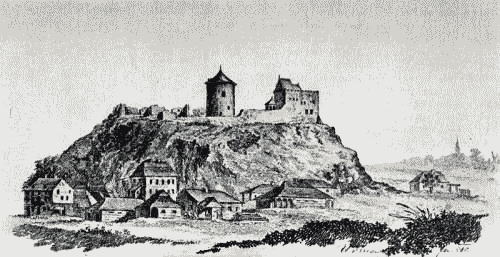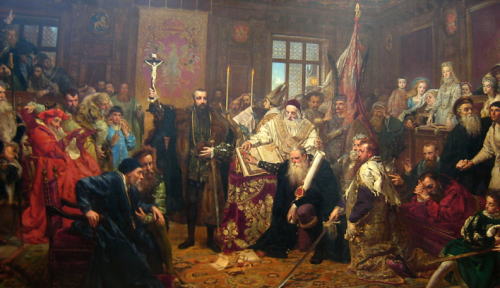|
|
| 前半 後半 全体 ■2009年3月13日 |
|
|
| 前半 後半 全体 ■2009年3月13日 |

| ●ルブリン城に入る 下はルブリン城(現在、ルブリン歴史博物館)の正面玄関だ。  撮影:青山貞一 Nikon Cool Pix S10 2009.3.13 下は正面の入り口の前に置かれたライオンの彫像。左右で2頭いる。  撮影:池田こみち Nikon Cool Pix S10 2009.3.13  撮影:池田こみち Nikon Cool Pix S10 2009.3.13 以下は入り口の受付近くにあるルブリン博物館の紋章。博物館の入場料は3.5zlだが、カメラ、ビデオを持ち込む場合は35zl、約1000円となる。 また城内にある聖三位一体礼拝堂(Kaplica sw. Trojcy)に入るには別途料金を 事前に受付で支払う。 私たちは聖三位一体礼拝堂に入ったが、撮影厳禁となっていたので写真は撮影しなかった。  撮影:青山貞一 Nikon Cool Pix S10 2009.3.13 開門とともに博物館の中に入るポーランドの中学生。  撮影:青山貞一 Nikon Cool Pix S10 2009.3.13 ルブリン城は14世紀に城として建築されたが、変遷をたどって17世紀に現在の形となっている。このルブリン城は、正門を入ってすぐに見える下の写真にある中庭が秀逸で美しい。 後述(英語)するように、この城は第2次世界大戦の1939年から1944年のナチスドイツ占領時代、政治犯らを収容する刑務所(牢獄)として使われた過去を持っている。  ルブリン城の中庭。城全体が博物館となっている 撮影:青山貞一 Nikon Cool Pix S10 2009.3.13 入り口を入ってすぐの中庭にある井戸。  撮影:青山貞一 Nikon Cool Pix S10 2009.3.13 井戸の前で説明を受けるポーランドの中学生。おそらくポーランドほど歴史関連の博物館が整備され、低料金で解放されている国はないだろう。子供達は小中高等学校の教育を通じて、ポーランドの歴史を座学ではなく実物を前に学ぶことが出来る。  撮影:池田こみち Nikon Cool Pix S10 2009.3.13  以下はルブリン城の歴史である。 Lublin Castle (Polish: Zamek
Lubelski) Under the rule of the Jagiellon dynasty the castle enjoyed royal favor and frequent stays by members of the royal family. In the 16th century it was rebuilt on a grandiose scale, under the direction of Italian masters brought from Krakow. The most momentous event in the castle's history was the signing in 1569 of the Union of Lublin, the founding act of the Polish-Lithuanian Commonwealth. As a consequence of the wars in the 17th century (The Deluge) the castle
fell into disrepair. Only the oldest sections, the keep and the chapel,
remained intact. After Lublin fell under Russian rule following the territorial
settlement of the Congress of Vienna in 1815, the government of Congress
Poland, on the initiative of Stanis?aw Staszic, carried out a complete
reconstruction of the castle between 1826 and 1828. The castle served as a prison for the next 128 years: as a Tsarist prison
from 1831 to 1915, in independent Poland from 1918 to 1939, and most infamously during the Nazi occupation of the city from 1939 to
1944, when between 40,000 and 80,000 inmates, many of them Polish resistance
fighters, passed through the prison. In 1954 the castle prison was finally closed. Following reconstruction and refurbishment, since 1957 it has been the main site of the Lublin Museum. 現在、このルブリン城はクラクフ門同様、博物館として利用されており、17世紀から19世紀の絵画、食器、燭台、民族衣装、貨幣など多数の文物を見ることが出来る。下は1810年のルブリンの丘にそびえ立つルブリン城と下はユダヤ人居住区  Lublin Castle Hill and the Jewish district in 1810. Source:English Wikimedia  撮影:青山貞一 Nikon Cool Pix S10 2009.3.13  撮影:青山貞一 Nikon Cool Pix S10 2009.3.13  撮影:青山貞一 Nikon Cool Pix S10 2009.3.13  撮影:青山貞一 Nikon Cool Pix S10 2009.3.13 このルブリン博物館にある絵画でとりわけ重要かつ有名なのは、「ルブリン合同」を素材にヤン・マテイコが書いた『ルブリン合同』の絵画である。 この巨大な絵画はルブリン城の2階に掲示されている。  1569年のルブリン合同の絵画 下はルブリン合同の絵画についての解説である。
以下は食器、燭台の展示。  撮影:青山貞一 Nikon Cool Pix S10 2009.3.13 下は中世から近代までの武器を展示しているコーナーで先生の説明に聞き入るポーランドの中学生たち。長い間真剣に聞き入っていた。  撮影:青山貞一 Nikon Cool Pix S10 2009.3.13  撮影:青山貞一 Nikon Cool Pix S10 2009.3.13  撮影:青山貞一 Nikon Cool Pix S10 2009.3.13  撮影:青山貞一 Nikon Cool Pix S10 2009.3.13 なお、本稿の冒頭に書いたが、城内にある聖三位一体礼拝堂(Kaplica sw. Trojcy)にある多くのフラスコ画は、1418年に描かれたロシア・ビザンチン様式の貴重なフラスコ画であり一見の価値がある。 以下は聖三位一体礼拝堂(Kaplica sw. Trojcy)の外に掲示されていた礼拝堂写真を写したもの。それはもうすばらしいの一言である。  城内にある聖三位一体礼拝堂(Kaplica sw. Trojcy)の写真 つづく |